Overview
- Brief Narrative
- Wooden rubber stamp handle used by Rabbi Nathan Baruch when he was the director of the Vaad Hatzala Rescue Organization in Germany from September 1946 - September 1949. Vaad Hatzala was originally established to rescue Polish rabbis and yeshiva students who escaped to Lithuania at the start of World War II in 1939. It expanded to include assistance to all Jews. Rabbi Baruch was responsible for the reestablishment of Jewish religious life in post war Europe. He supervised the creation and distribution of religious texts and items to displaced persons camps as well as to Jewish communities worldwide. Rabbi Baruch, working closely with the United States Army, was largely responsible for the printing of the 19 volume Heidelberg Talmud in 1949.
- Date
-
use:
1946-1949
- Geography
-
use:
Vaad Hatzala office;
Munich (Germany)
- Credit Line
- United States Holocaust Memorial Museum Collection, Gift of Doris Baruch
- Contributor
-
Subject:
Nathan Baruch
Subject: Vaad Hatzala
- Biography
-
Rabbi Nathan Baruch was born on June 7, 1921. He was the director of Vaad Hatzala in Germany from September 1946 to September 1949. The Vaad Hatzala Rescue Committee was originally established in November 1939 to rescue Polish rabbis and yeshiva students who escaped to Lithuania at the beginning of World War II. It later expanded to include assistance to all Jewish Holocaust survivors. Rabbi Baruch established the central Vaad Hatzala office in Germany and was responsible for reestablishing Jewish religious life in Europe. His duties included the printing and distribution of religious items, including prayer books, haggadahs, Torahs, pocket sized editions of the Talmud, and other sefarim. Rabbi Baruch was instrumental in getting the United States Army to print, in 1948, the 19 volume Heidelberg Talmud. The texts were distributed to displaced persons camps and Jewish communities worldwide. He married, had a daughter, and died in Long Beach, New York, on November 28, 2001, at the age of 81.
Vaad Hatsala was established in November 1939, by the Union of Orthodox Rabbis of the United States and Canada. Its mission was to rescue Polish rabbis and yeshiva students who fled to Lithuania at the onset of World War II. Vaad made it possible for numerous rabbis and Torah scholars to emigrate from Lithuania to the Far East prior to the German invasion in June 1941. After the United States entered the war, Vaad Hatsala focused on providing funds, food and clothing to refugees so that they could adhere to their Orthodox lifestyle and continue their studies. In January, 1944, the organization officially changed their mission to include all Jews, regardless of religiosity or affiliation, and focused on those living in areas that had been occupied by Germans. Vaad Hatsala had branches in Switzerland, Sweden, Turkey, and Tangier. Through these branches they initiated various successful rescue projects, most notably the release of 1,210 inmates from the concentration camp Theresienstadt to Switzerland on February 6-7, 1945. The organization ceased operations in the early 1950s.
Physical Details
- Classification
-
Office Equipment and Supplies
- Category
-
Marking devices
- Object Type
-
Rubber stamps (lcsh)
- Physical Description
- Light brown, turned, unfinished wooden rubber stamp handle. The handle top is cut at an angle and there is a silver colored head pin on the side. The handle tapers towards the attached wedge shaped section. There is no evidence of a mount.
- Dimensions
- overall: Height: 2.120 inches (5.385 cm) | Width: 1.120 inches (2.845 cm) | Depth: 1.000 inches (2.54 cm)
- Materials
- overall : wood, metal
Rights & Restrictions
- Conditions on Access
- No restrictions on access
- Conditions on Use
- No restrictions on use
Keywords & Subjects
Administrative Notes
- Legal Status
- Permanent Collection
- Provenance
- The rubber stamp was donated to the United States Holocaust Memorial Museum in 2008 by Doris Baruch, the widow of Nathan Baruch.
- Record last modified:
- 2022-07-28 18:26:09
- This page:
- https://collections.ushmm.org/search/catalog/irn37142
Also in Nathan Baruch collection
The collection consists of artifacts, documents, photographs, and publications relating to the experiences of Rabbi Nathan Baruch as director of the Vaad Hatzala Rescue Organization in Germany from 1946-1949.
Date: 1946-1948
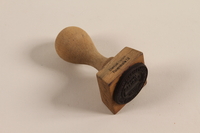
Official address stamp, Director, Vaad Hatzala Emergency Committee postwar
Object
Circular rubber stamp used by Rabbi Nathan Baruch when he was the director of the Vaad Hatzala Rescue Organization in Germany from September 1946 - September 1949. Vaad Hatzala was originally established to rescue Polish rabbis and yeshiva students who escaped to Lithuania at the start of World War II in 1939. It expanded to include assistance to all Jews. Rabbi Baruch was responsible for the reestablishment of Jewish religious life in post war Europe. He supervised the creation and distribution of religious texts and items to displaced persons camps as well as to Jewish communities worldwide. Rabbi Baruch, working closely with the United States Army, was largely responsible for the printing of the 19 volume Heidelberg Talmud in 1949.
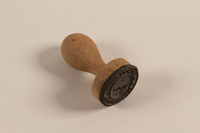
Official rubber stamp with Hebrew text, Director of the Vaad Hatzala Emergency Committee postwar
Object
Round rubber stamp used by Rabbi Nathan Baruch when he was the director of the Vaad Hatzala Rescue Organization in Germany from September 1946 - September 1949. Vaad Hatzala was originally established to rescue Polish rabbis and yeshiva students who escaped to Lithuania at the start of World War II in 1939. It expanded to include assistance to all Jews. Rabbi Baruch was responsible for the reestablishment of Jewish religious life in post war Europe. He supervised the creation and distribution of religious texts and items to displaced persons camps as well as to Jewish communities worldwide. Rabbi Baruch, working closely with the United States Army, was largely responsible for the printing of the 19 volume Heidelberg Talmud in 1949.
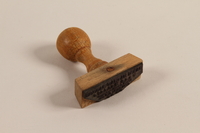
Official rectangular address stamp, Director of the Vaad Hatzala Emergency Committee postwar
Object
Rectangular, rubber identification stamp used by Rabbi Nathan Baruch when he was the director of the Vaad Hatzala Rescue Organization in Germany from September 1946 - September 1949. Vaad Hatzala was originally established to rescue Polish rabbis and yeshiva students who escaped to Lithuania at the start of World War II in 1939. It expanded to include assistance to all Jews. Rabbi Baruch was responsible for the reestablishment of Jewish religious life in post war Europe. He supervised the creation and distribution of religious texts and items to displaced persons camps as well as to Jewish communities worldwide. Rabbi Baruch, working closely with the United States Army, was largely responsible for the printing of the 19 volume Heidelberg Talmud in 1949.
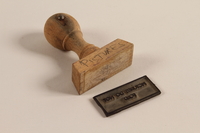
Official photo ID stamp and handle, Director of the Vaad Hatzala Emergency Committee postwar
Object
Rectangular rubber stamp and handle used by Rabbi Nathan Baruch when he was the director of the Vaad Hatzala Rescue Organization in Germany from September 1946 - September 1949. Vaad Hatzala was originally established to rescue Polish rabbis and yeshiva students who escaped to Lithuania at the start of World War II in 1939. It expanded to include assistance to all Jews. Rabbi Baruch was responsible for the reestablishment of Jewish religious life in post war Europe. He supervised the creation and distribution of religious texts and items to displaced persons camps as well as to Jewish communities worldwide. Rabbi Baruch, working closely with the United States Army, was largely responsible for the printing of the 19 volume Heidelberg Talmud in 1949.
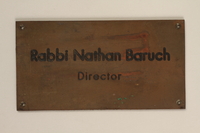
Engraved brass wall nameplate for the director of the Vaad Hatzala Emergency Committee in postwar Germany
Object
Office wall plaque used by Rabbi Nathan Baruch when he was the director of the Vaad Hatzala Rescue Organization in Germany from September 1946 - September 1949. Vaad Hatzala was originally established to rescue Polish rabbis and yeshiva students who escaped to Lithuania at the start of World War II in 1939. It expanded to include assistance to all Jews. Rabbi Baruch was responsible for the reestablishment of Jewish religious life in post war Europe. He supervised the creation and distribution of religious texts and items to displaced persons camps as well as to Jewish communities worldwide. Rabbi Baruch, working closely with the United States Army, was largely responsible for the printing of the 19 volume Heidelberg Talmud in 1949.
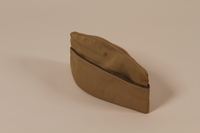
U.S. army issue khaki cap worn by the director of the Vaad Hatzala Emergency Committee in postwar Germany
Object
Cap worn by Rabbi Nathan Baruch when he was the director of the Vaad Hatzala Rescue Organization in Germany from September 1946 - September 1949. Vaad Hatzala was originally established to rescue Polish rabbis and yeshiva students who escaped to Lithuania at the start of World War II in 1939. It expanded to include assistance to all Jews. Rabbi Baruch was responsible for the reestablishment of Jewish religious life in post war Europe. He supervised the creation and distribution of religious texts and items to displaced persons camps as well as Jewish communities worldwide. Rabbi Baruch, working closely with the United States Army, was largely responsible for the printing of the 19 volume Heidelberg Talmud in 1949.
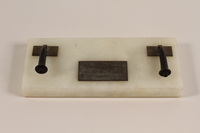
Personalized desk set on a marble base used by the director of the Vaad Hatzala Emergency Committee in postwar Germany
Object
Desk set with penholders and plaque used by Rabbi Nathan Baruch when he was the director of the Vaad Hatzala Rescue Organization in Germany from September 1946 - September 1949. Vaad Hatzala was originally established to rescue Polish rabbis and yeshiva students who escaped to Lithuania at the start of World War II in 1939. It expanded to include assistance to all Jews. Rabbi Baruch was responsible for the reestablishment of Jewish religious life in post war Europe. He supervised the creation and distribution of religious texts and items to displaced persons camps as well as Jewish communities worldwide. Rabbi Baruch, working closely with the United States Army, was largely responsible for the printing of the 19 volume Heidelberg Talmud in 1949.
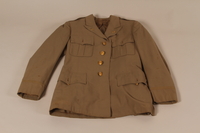
US Army officer's summer weight tunic worn by the director of the Vaad Hatzala Emergency Committee in postwar Germany
Object
United States Army uniform jacket worn by Rabbi Nathan Baruch when he was the director of the Vaad Hatzala Rescue Organization in Germany from September 1946 - September 1949. It has its officer's buttons but no rank insignia. Vaad Hatzala was originally established to rescue Polish rabbis and yeshiva students who escaped to Lithuania at the start of World War II in 1939. It expanded to include assistance to all Jews. Rabbi Baruch was responsible for the reestablishment of Jewish religious life in post war Europe. He supervised the creation and distribution of religious texts and items to displaced persons camps as well as to Jewish communities worldwide. Rabbi Baruch, working closely with the United States Army, was largely responsible for the printing of the 19 volume Heidelberg Talmud in 1949.
The Rabbi Nathan Baruch collection Related to Vaad Hatzala for Germany
Document
Contains materials related to Rabbi Nathan Baruch’s Directorship of the Vaad Hatzala for Germany, 1946-1948 and that organization’s activities related to the reestablishment of Jewish religious life. Includes a photo album, two scrapbooks, and one haggadah.




